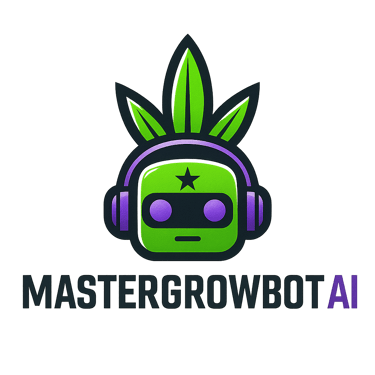Election 2024: How AI and Blockchain Could Finally Bring Legal Cannabis Nationwide
Cannabis, once a symbol of counterculture and rebellion, has grown into one of the most rapidly evolving industries of our time. And as the United States heads toward the November 2024 election, both leading candidates are positioning cannabis reform and the acceptance of blockchain technology as major policy points. With these technologies potentially serving as the backbone of the industry, we could be on the brink of a new economic and technological boom—one that intertwines the future of cannabis, AI, and blockchain in ways that transform the entire landscape.


Cannabis, once a symbol of counterculture and rebellion, has grown into one of the most rapidly evolving industries of our time. And as the United States heads toward the November 2024 election, both leading candidates are positioning cannabis reform and the acceptance of blockchain technology as major policy points. With these technologies potentially serving as the backbone of the industry, we could be on the brink of a new economic and technological boom—one that intertwines the future of cannabis, AI, and blockchain in ways that transform the entire landscape.
From powerful AI algorithms optimizing cultivation to blockchain technology offering transparency and security, the cannabis industry is no longer just about growing plants. It’s about building an entire ecosystem where cutting-edge technology plays a crucial role. This isn’t just a green rush; it’s a digital revolution that could be supercharged by the political climate and policy changes on the horizon.
AI in Cannabis Cultivation: From Seed to Sensation, Powered by Algorithms
Artificial Intelligence (AI) is becoming an increasingly vital tool in the cannabis sector, particularly in cultivation. Drones and IoT devices are just the beginning; the real magic happens behind the scenes, where machine learning algorithms and deep learning neural networks are at work. These systems collect enormous amounts of data from sensors monitoring moisture levels, light exposure, soil nutrients, and more, feeding all that information into complex AI models.
These models—growing more powerful and sophisticated over time—aren’t just about monitoring; they predict. They learn patterns, analyze environmental data, and can even identify disease outbreaks before they become catastrophic, allowing cultivators to act preemptively. As these algorithms continuously absorb more data, they evolve, becoming more accurate and efficient with each growing season. Deep learning neural networks, for instance, can adapt to subtle changes in weather patterns or pest behavior, meaning every season gets a little smarter and a lot more profitable.
This isn’t just efficiency for efficiency’s sake. With the upcoming election cycle, both major parties are eyeing cannabis as an economic engine, particularly for rural communities that could benefit from high-tech, high-yield farming methods. AI’s growing capability could be the key to turning cannabis into a sustainable, nationally-scaled industry that boosts job creation and regional economies. The November ballot could be the tipping point that legitimizes the industry, harnessing AI’s power to its full extent.
Blockchain for Transparency and Compliance: Revolutionizing the Seed-to-Sale Model
As the cannabis industry grows, so too does the need for transparency and regulatory compliance. The current Seed-to-Sale tracking programs mandated by governments aim to provide traceability, ensuring that every cannabis plant is monitored from germination to the point it hits retail shelves. However, the existing systems are far from perfect. State-run tracking programs are often plagued with inefficiencies—outdated software, human error in data entry, and gaps in traceability that make it difficult for regulators to truly guarantee product safety and compliance.
These inefficiencies are not just logistical headaches; they’re barriers to consumer trust and legal consistency. When systems fail to update or accurately record information, businesses risk fines, consumers are left in the dark, and governments struggle to maintain control over a rapidly growing market. This is where blockchain technology can provide a far superior solution.
Blockchain’s immutable ledger structure offers a robust, tamper-proof system where every transaction—from seed planting to final sale—is recorded permanently. By integrating blockchain technology into the cannabis supply chain, companies and regulators can access real-time, verifiable data. Every step in the plant’s journey—whether it’s a genetic modification, lab testing, or transport—gets logged onto the blockchain, ensuring that the record is transparent and cannot be altered retroactively.
This level of traceability solves the inefficiencies of traditional Seed-to-Sale tracking, offering a more reliable and efficient way to monitor compliance. And as blockchain technology continues to mature, it offers the potential for even more innovations like automated compliance reporting, which could save businesses and governments millions in auditing and regulatory costs.
Economic and Market Impacts: Blockchain and AI as Industry Game-Changers
By leveraging AI and blockchain, the cannabis industry could reach new heights in economic potential. The 2024 election presents an unprecedented opportunity to legalize cannabis federally, which would open the floodgates for interstate commerce, international trade, and substantial new revenue streams. If both candidates, as expected, push for not only federal legalization but also the acceptance of Bitcoin and blockchain technology, the industry could see an economic boom like never before.
Imagine this: blockchain-based platforms enabling microtransactions, allowing small-scale farmers to compete with the larger players by reaching customers directly with full transparency. AI would then power these platforms, providing predictive analytics for pricing, consumer trends, and inventory management, ensuring that even the smallest operations are running efficiently and maximizing profits.
With AI’s ability to predict demand patterns and blockchain’s transparent ledger ensuring compliance, the cannabis industry could operate with a level of efficiency and trust that few other industries enjoy. And with a federal framework in place, there would be room for new business models—personalized cannabis subscriptions, international partnerships, and investment platforms that allow anyone to own a stake in a budding business, all supported by blockchain and AI.
The AI Evolution: More Power, More Precision
Machine learning algorithms and neural networks aren’t static; they’re dynamic, continuously evolving systems that get smarter as they ingest more data. In the cannabis industry, this means that each cycle—each harvest, each lab test, each environmental change—provides new data points for AI to process and learn from. Over time, these algorithms become more refined, making increasingly accurate predictions about plant health, growth cycles, and yield optimization.
Deep learning neural networks, which mimic the way the human brain works, are especially promising. They can detect patterns in massive datasets that would be impossible for a human to notice. This power can be applied to every aspect of cannabis cultivation, from identifying the optimal lighting conditions for a particular strain to customizing nutrient delivery systems that adjust in real time based on plant needs. The result is a cultivation process that becomes more precise, efficient, and profitable with every cycle.
By harnessing this technology, cannabis businesses could effectively double or triple their output without significantly increasing their costs—an economic windfall that could support legalization efforts as states and federal agencies see the potential tax revenue gains. And as AI continues to learn and evolve, these benefits will only compound, making cannabis cultivation one of the most technologically advanced forms of agriculture in the modern world.
Blockchain: Solving the Seed-to-Sale Problem Once and For All
The promise of blockchain goes beyond mere compliance. It has the potential to completely overhaul how the cannabis industry operates by providing a transparent, secure, and efficient system for tracking products from cultivation to consumption. The problems with current Seed-to-Sale programs are not just inconvenient; they’re detrimental to industry growth. Without reliable systems, cannabis businesses are vulnerable to fraud, mislabeling, and regulatory penalties.
Blockchain’s distributed ledger technology (DLT) addresses these issues head-on. It provides a permanent, unalterable record for each step in the cannabis production and distribution process, making it nearly impossible to falsify information. This is crucial for an industry still grappling with legitimacy and safety concerns. With blockchain, consumers can verify the origin and quality of their cannabis products simply by scanning a QR code, while regulators can trust that data entries haven’t been tampered with or altered.
This system doesn’t just enhance consumer trust; it also allows businesses to streamline operations. Blockchain’s automation capabilities mean that compliance reports can be generated automatically and audited in real time, reducing human error and administrative costs. For an industry on the brink of federal legalization, such a solution is not just advantageous—it’s essential for scaling up and entering new markets.
The Election Catalyst: November 2024 and the Legal Cannabis Boom
As we look toward the 2024 election, it’s clear that cannabis reform is becoming a central issue. Both major candidates have expressed support for federal legalization, with platforms that also advocate for embracing blockchain and cryptocurrency technology as integral parts of the new economy. The convergence of these factors—political will, public support, and technological advancements—could lead to a historic shift.
Federal legalization would open the floodgates for cannabis businesses to expand across state lines, while blockchain technology would ensure that this expansion happens smoothly and transparently. Meanwhile, AI will continue to refine cultivation practices, making American cannabis the highest quality and most efficiently grown in the world. If the political stars align, the U.S. could become a global cannabis powerhouse, setting the standard for a new era of transparent, tech-driven agricultural production.
Conclusion: The Digital Future of Cannabis Awaits
Cannabis is on the cusp of a technological and economic transformation. AI and blockchain technologies are not just tools; they are the engines driving this change. As we head into the November 2024 election, the stakes couldn’t be higher. If both candidates follow through on their promises, we could witness the legal cannabis boom that industry advocates have long anticipated.
From optimized cultivation to transparent supply chains, the future of cannabis looks bright—green, yes, but also very digital. The revolution isn’t just about changing laws; it’s about harnessing technology to build a cannabis industry that is more efficient, more transparent, and more accessible than ever before.
Spread the Vision
Liked This Article?
If you found this article as enlightening as a well-rolled joint at sunset, share it with your fellow canna-entrepreneurs! For more insights into the exciting intersection of AI and cannabis, check out the book "AI High" by Eli Duffy, just click the link to see it on Amazon. Dive into the world of AI-powered cannabis innovation and take your understanding to the next level.
Ready to harness your AI Cannabis SuperPowers? Visit www.futuristiccannabis.ai today and embark on your journey into the future of cannabis technology. Don't miss out on the opportunity to revolutionize your approach to cannabis marketing and cultivation—your success is just a click away!
In this brave new world, cannabis isn’t just grown—it’s crafted with a precision that borders on the magical, offering a glimpse into a future where the impossible becomes possible, and where the boundaries of nature and technology blur into something extraordinary.
